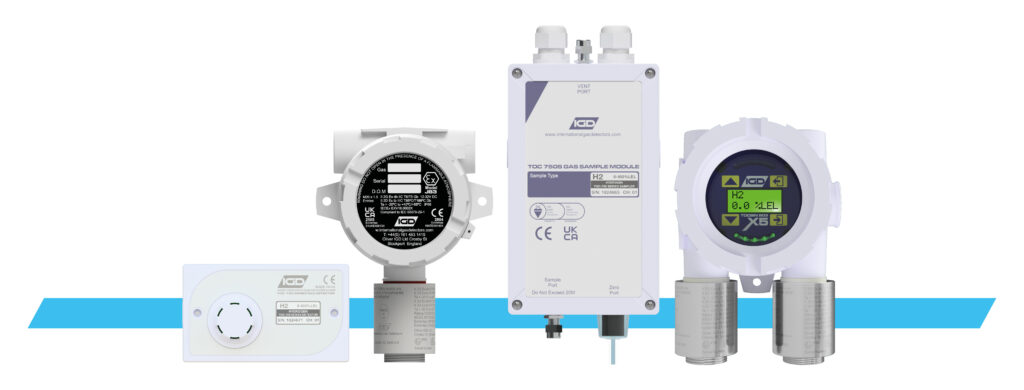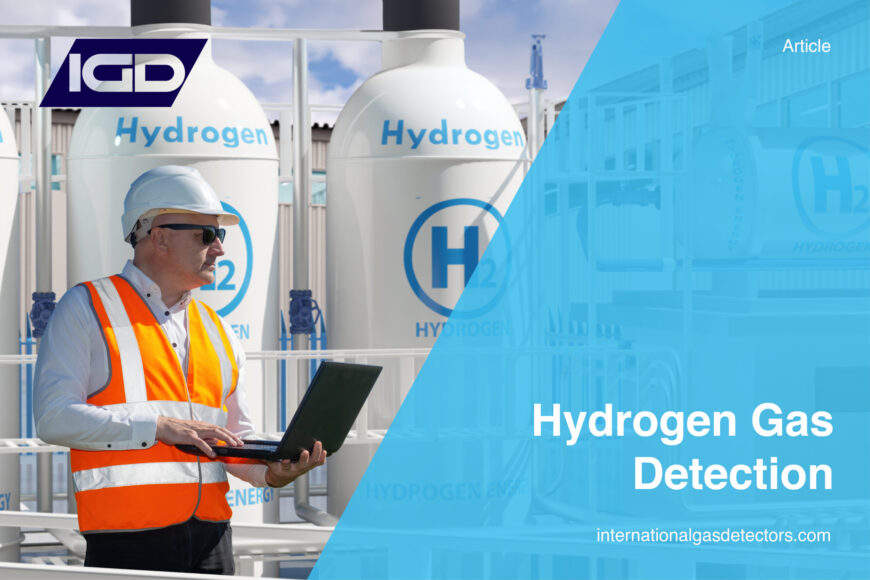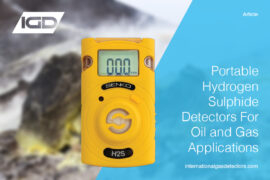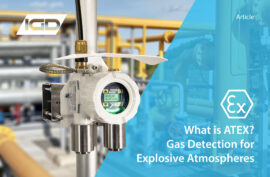Hydrogen is becoming an increasingly popular choice for the industrial sector. However, as the demand for hydrogen increases, there will be an even greater need for more readily available and reliable hydrogen gas detection systems.1,2 As a manufacturer of gas detection equipment for over 100 years, International Gas Detectors (IGD) offers a range of hydrogen gas detector devices to meet the site requirements of our customers. Our newest product, the MK8 Pellistor, is the perfect solution for hydrogen gas detection and is used in the TOC-750 safe area, TOC-750X ATEX detector, TOC-750S sampling detector, and TOC-903-X5 dual gas transmitter.3 This article will explore some of the key features of the MK8 Pellistor and how it is setting the standard for the detection of hydrogen.
The Importance of Hydrogen Gas Detection
As mentioned before, hydrogen is used widely across various applications, and with its widespread use comes the importance of knowing the dangers. Green and blue hydrogen are the most common types of hydrogen being used as a substitute across the energy sector. The appeal of using hydrogen as opposed to natural gases is that it burns ‘cleanly’ with only water as a combustion product, not carbon dioxide. With Hydrogen becoming the ‘fuel of the future’ and having a low explosive limit, it is essential to implement gas detection that can accurately detect hydrogen as low as 4%VOL.
H2 is the smallest molecule in the universe, therefore, it is very likely to leak from containment. This does not pose a massive threat to personnel as it is non-toxic. However hydrogen is extremely flammable.4

Hydrogen in the air is flammable at concentrations between 4% and 75%, and the energy required to ignite this gas is low compared to most flammable gases. For example, the energy required to ignite a hydrogen and oxygen mix is as low as 0.017 mj, whereas gasoline ignites at around 0.25 mj. Implementing a hydrogen gas detector is therefore vital to ensure personnel and plants are not put in danger of explosive atmospheres.5
The MK8 Pellistor
A key factor in the uptake of hydrogen fuels is ensuring that these can be used safely. Achieving a hydrogen infrastructure in vehicles and home and commercial HVAC systems means that reliable hydrogen detection is absolutely crucial. The lower explosive limit of 4 % means hydrogen detectors need to be very sensitive and also immune to some of the complications that come with sensor poisoning..
The new MK8 Pellistor from IGD offers both the necessary posion resistance and sensitivity for use as a hydrogen safety gas sensor. Poisoning occurs when a substance interferes with the normal operation of a gas sensor, resulting in a decrease in sensitivity or accuracy.6 This can be a common issue with hydrogen gas detectors, as hydrogen is often used in the presence of other gases that can interfere with the sensor. The MK8 offers the greatest poison resistance of any detector in the world, ensuring that poisoning factors are no longer an issue, ensuring accurate gas detection for longer.
Another key feature of the MK8 Pellistor is its long operational life. A hydrogen gas detector that is in use for extended periods of time is exposed to various environmental conditions that can lead to wear and tear. The MK8 Pellistor has surpassed the market standard of lifetime expectations, setting a new standard for the lifetime of pellistor gas detectors. With the longest life of any pellistor in the world, the MK8 Pellistor from IGD provides accurate and reliable readings for years to come.
The MK8 Pellistor can detect hydrogen at a range of 0-100% LEL (Lower Explosive Limit). This means that it can detect hydrogen gas at low levels before it reaches an explosive concentration. By detecting hydrogen at low levels, the MK8 Pellistor provides ample time for the occupants of the room to evacuate and for the hydrogen to be safely ventilated.7
The MK8 Pellistor is also designed with minimal zero drift, which refers to the gradual shift in the baseline measurement of the gas sensor over time. Zero drift can lead to inaccurate readings and the need for frequent calibrations. The minimal zero drift of the MK8 Pellistor ensures that it provides accurate and reliable readings for an extended period without the need for frequent calibrations.

Available in different formats, the MK8 Pellistor is able to meet the needs of various applications and industries, including the TOC-750 safe area, which is ideal for hydrogen packs and boilers. The TOC-750X, TOC-750S, and TOC-903-X5 product range is very well-suited for hydrogen generation applications, such as hydrogen electrolysis, and can also be used in cleanrooms or engine test beds.8 Each of these products is designed to meet the specific requirements of a particular application or industry, ensuring that our customers have the right hydrogen gas detector for their needs.3
The MK8 Pellistor is also designed to include all the benefits of 2-wire addressable technology. This technology enables the hydrogen gas detector to communicate directly with a control panel, allowing for real-time monitoring and control of the hydrogen gas levels. In addition, 2-wire addressable technology reduces the number of wires required for installation, making it a more cost-effective solution for hydrogen gas detection.
A Legacy of Innovation
IGD has a long history of innovation in the gas detection industry, starting with the first electronic flammable gas detector in 1917 – the Ringrose Methanometer. Over the years, IGD has continued to push the boundaries of gas detection technology and has become a leader in the industry. With over 100 years of experience, IGD has created the latest in hydrogen gas detection technology with the introduction of the MK8 Pellistor.
Conclusion
The MK8 Pellistor is the detectably better choice for hydrogen gas detection. With its resistance to poisoning, long life, 0-100% LEL hydrogen detection, and versatility, the MK8 Pellistor is the ideal solution for a wide range of applications. Combined with the benefits of 2-Wire Addressable technology, the MK8 Pellistor provides the accuracy, reliability, and versatility that you need for your hydrogen gas detection requirements.
The importance of hydrogen gas detection cannot be overstated. Whether you are dealing with hydrogen electrolyser facilities or any other application where hydrogen gas is a concern, IGD’s range of hydrogen gas detection solutions is the detectably better choice. With our 100 years of flammable gas detection experience, combined with the new MK8 Pellistor and ppm hydrogen sensors, you can be assured of the highest level of safety and peace of mind.

Contact IGD today to find out more about our MK8 flammable gas detector and how it can be integrated into your gas detection system.
References
- International Gas Detectors. “Flammable Gas Detectors for Bus Garages.” International Gas Detectors, www.internationalgasdetectors.com/flammable-gas-detectors-bus-garages/.
- Cames, M., & Helmers, E. (2013). Critical evaluation of the European diesel car boom – global comparison , environmental effects and various national strategies. Environmental Sciences Europe, 25(15), 1–22. https://doi.org/10.1016/j.coche.2021.100701
- International Gas Detectors. “Hydrogen Gas Detection.” International Gas Detectors, www.internationalgasdetectors.com/applications/hydrogen-gas-detection/.
- Yang, F., Wang, T., Deng, X., & Dang, J. (2021). Review on hydrogen safety issues : Incident statistics , hydrogen diffusion , and detonation process. International Journal of Hydrogen Energy, 46(61), 31467–31488. https://doi.org/10.1016/j.ijhydene.2021.07.005
- Buttner, W. J., Post, M. B., Burgess, R., & Rivkin, C. (2010). An overview of hydrogen safety sensors and requirements. International Journal of Hydrogen Energy, 36(3), 2462–2470. https://doi.org/10.1016/j.ijhydene.2010.04.176
- Hübert, T., Boon-brett, L., Black, G., & Banach, U. (2011). Chemical Hydrogen sensors – A review. Sensors and Actuators B, 157, 329–352. https://doi.org/10.1016/j.snb.2011.04.070
- International Gas Detectors. “Hydrogen (H2).” International Gas Detectors, www.internationalgasdetectors.com/gases/hydrogen-h2/.
- International Gas Detectors. “What is Blue and Green Hydrogen?” International Gas Detectors, www.internationalgasdetectors.com/what-blue-green-hydrogen/.




